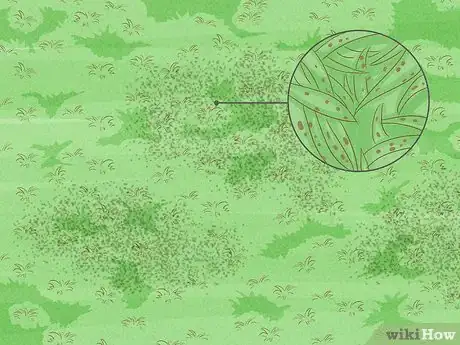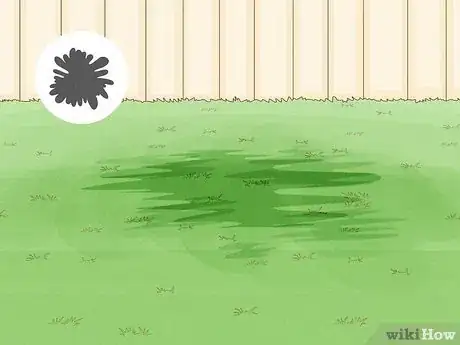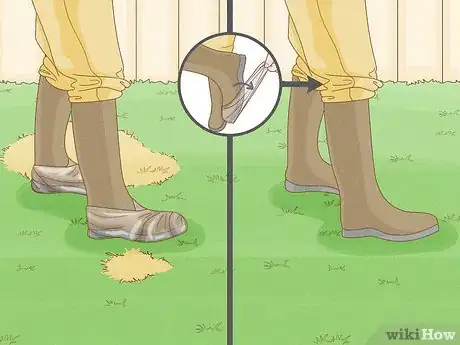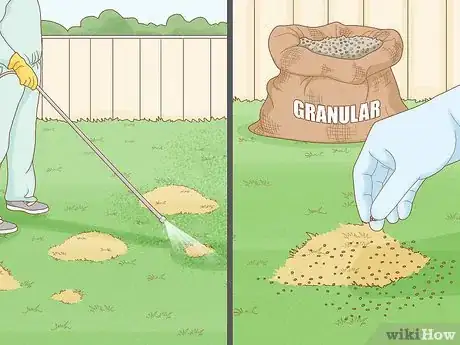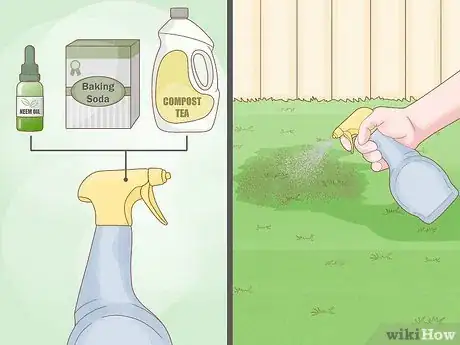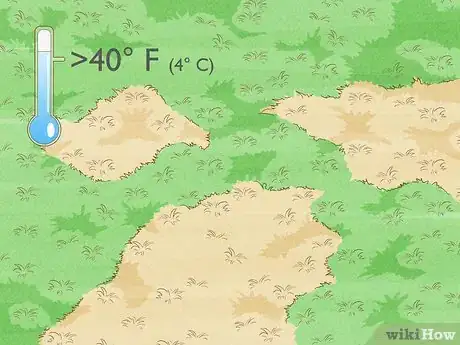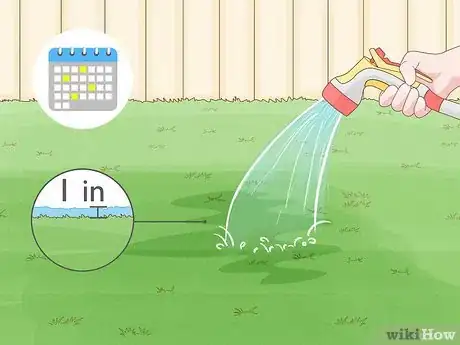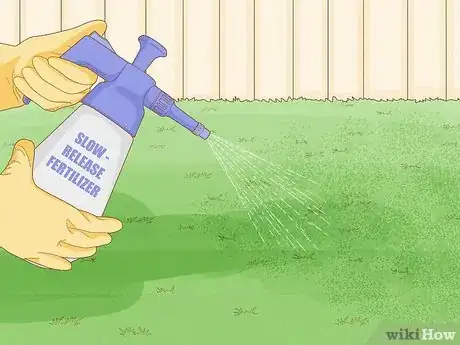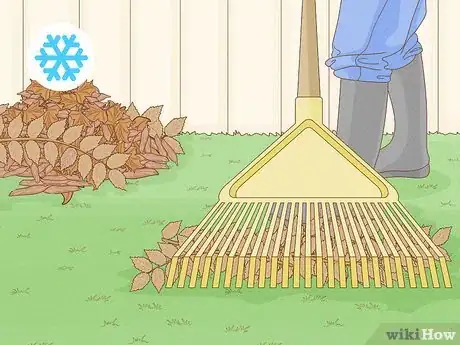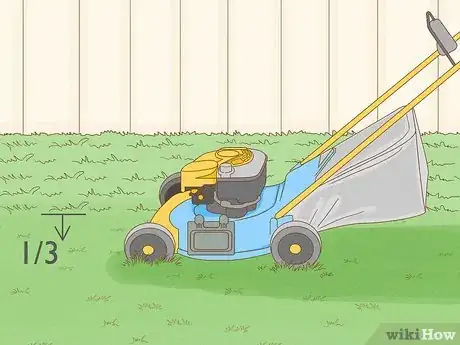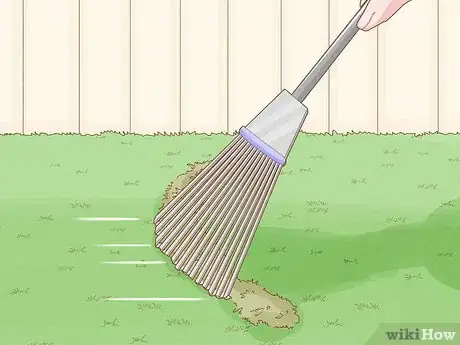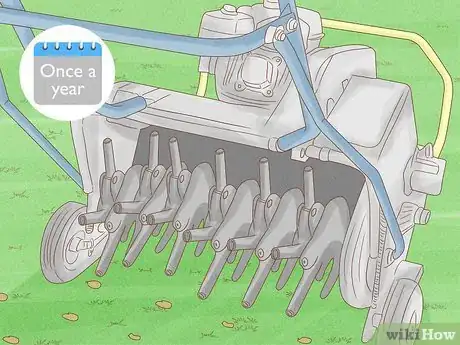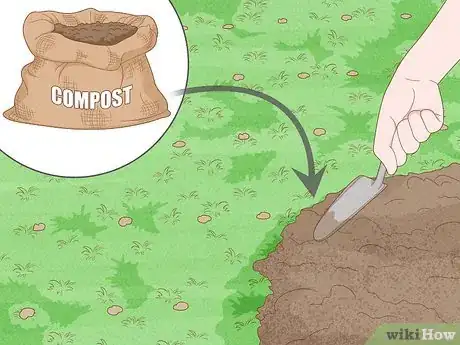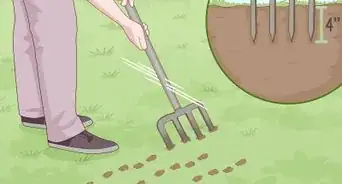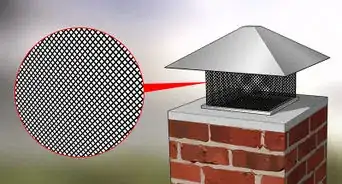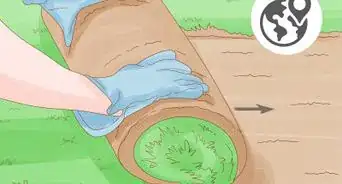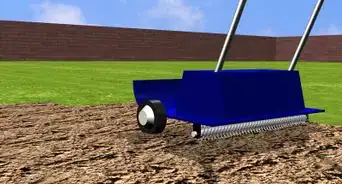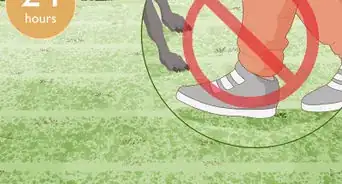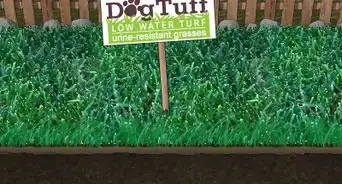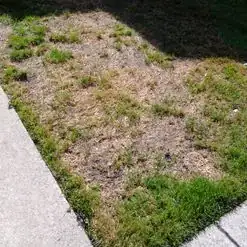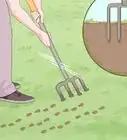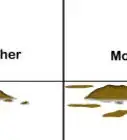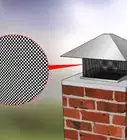This article was co-authored by Anthony "TC" Williams. Anthony "TC" Williams is a Professional Landscaper in Idaho. He is the President and Founder of Aqua Conservation Landscape & Irrigation, an Idaho Registered Landscape Business Entity. With over 21 years of landscaping experience, TC has worked on projects such as the Idaho Botanical Garden in Boise, Idaho. He is a Idaho Registered Contractor and a previously Licensed Irrigator in the State of Texas.
There are 8 references cited in this article, which can be found at the bottom of the page.
wikiHow marks an article as reader-approved once it receives enough positive feedback. In this case, 83% of readers who voted found the article helpful, earning it our reader-approved status.
This article has been viewed 434,422 times.
Finding lawn fungus on your grass can be frustrating. It can appear as gray spots, an orange-red powder, stringy red threads, and irregular brown patches. If your lawn is plagued by fungus, you'll want to take quick action to prevent it from spreading. Once you've identified your lawn fungus, you can choose a treatment method. You should also take steps to prevent lawn fungus, as prevention is the best treatment.
Steps
Identifying Fungal Diseases
-
1Look for thin, irregular white, yellow, or brown patches. The patches could be irregular-shaped splotches or rings. You will likely see the soil through the grass, which will look frayed. The patches will likely continue to grow in diameter over time.[1]
-
2Watch for gray, black, orange, red, or purple spots on grass or stems. This can be a sign of leaf spot, a fungal infection that will travel down the blades of grass, resulting in root rot. Over time, your grass will die. The fungal infection will continue to spread outward if it's left untreated.[2]Advertisement
-
3Check for gray, black, or pink powder or threadlike coating on the grass. This can indicate red thread, pink patch, or powdery mildew. Red-thread and pink patch often occur together, and they spread easily. Powdery mildew can also spread, though it's not likely to penetrate the soil.[3]
-
4Notice grass that has become dark, wet, and slimy. This is called grease spot, which is most common in humid environments. If you have grease spot, you may also notice a white, cotton-like fungus growing around the slimy area.[4]
Treating Lawn Fungus
-
1Avoid tracking the fungus across other parts of your yard. Fungal diseases spread easily, so your footsteps, lawnmower, or wheelbarrow can easily allow the disease to spread to healthy parts of your yard. When you must walk through the area, cover your footwear with plastic wrap, removing it before stepping onto clean grass.[5]
- Be sure to catch and remove all grass clippings when mowing.
-
2Apply a fungicide to your lawn. Choose a fungicide that addresses the infection you have in your yard. There are two types of fungicide: contact and systemic. Contact fungicide comes in a liquid. It coats the surface of the plant and kills the spores it comes in contact with. It normally wears off fast and is minimally effective. Systemic fungicide is usually granular and dissolves into the soil, where it's taken up into the root system. This treatment lasts longer.You should follow the instructions on your product's packaging.
- Benomyl is potent against a range of fungi, including snow mold, brown patch, and dollar spot.
- Triadimefon works well against anthracnose and rust.
- Chlorothalonil does best against brown patch and red thread.
- Fairy ring has no cure once it establishes itself in your lawn, and fungicides are only effective against necrotic ring spot if accompanied by a de-thatching process.[6]
-
3Try natural treatments that kill fungicide. If you don't like using chemicals, there are a few natural options you can try. Neem oil, compost tea, and baking soda solutions can all kill fungus.[7] Pour or sprinkle the natural treatment over the infected patch.
- These natural options work best on new growth or small quantities of fungus.
- Keep other people and pets away from the affected site for a few days after you apply the natural treatment.
-
4Expect some fungal infections to be seasonal. Certain fungal infections are affected by the weather. Gray snow mold usually goes away when the weather warms to temperatures above 40 degrees Fahrenheit (4 degrees Celsius). Rapidly warming weather could kill the mold immediately. Similarly, some thread molds go away when the sun warms and dries the lawn.[8] Other fungi, like powdery mold, thrive in dry weather with high humidity.[9]
- Fungal infections can go away on their own if you properly maintain your yard.
Preventing Lawn Fungus
-
1Water your lawn only when necessary. Most yards need only 1-inch (2.54 centimeters) of water weekly, but homeowners may water their lawn more than is necessary. Many fungi thrive in moist conditions, so overwatering makes it easier for fungi to grow.
- On the other hand, don't allow your lawn to get too dry, either. Dry soil will lead to weak grass that is more susceptible to disease.
- It's best to water in the morning because your soil will absorb the water it needs, allowing the extra water to evaporate throughout the rest of the day.[10]
- If you use a sprinkler, test it to make sure it is working properly. Measure how much water it is distributing in your yard so that you can adjust accordingly.
-
2Use a low-nitrogen, slow-release fertilizer. Fungal infections can occur due to either under- or over-fertilization. To maintain balance, choose an organic, slow-release fertilizer with potassium and nitrogen. Fertilizer can help your lawn fight off an infection by strengthening the grass.[11]
- Avoid too much nitrogen because it can cause fast growing grass that is weak, making it more susceptible to infection.
- Always follow the instructions on the packaging to avoid misapplication.
-
3Remove all leaves from your yard in winter. Gray snow mold can grow under fallen leaves if you leave them on your lawn. To prevent mold growth, rake up and remove all leaves before it snows.
-
4Keep your lawnmower at the highest setting. You should only cut ⅓ of the grass height at any given time. Rather than cutting your grass short, you should leave your lawn lush and thick because the fresh growth is weaker, making it more susceptible to the fungus. While it may be more work, long grass will keep your lawn healthier.[12]
- Keep your lawnmower blades sharp and clean.
- Mow your lawn a little shorter than usual before snow comes to help protect against snow mold.
-
5De-thatch your lawn to remove layers of dead plants. Thatch is usually made up of dead grass, leaves, roots, and stems, which can smother the soil. Your soil needs air circulation to prevent fungal infections, so de-thatching can help prevent an infection. [13]
- It's best to use a mechanical, gas powered de-thatch machine that could be rented at the local home improvement center or equipment rental store.
- De-thatching is usually done in the spring.
-
6Aerate your yard annually to break up the soil. Aeration will loosen the soil, preventing it from becoming too compacted. This is very important and should be done at least once a year ensure that water, fertilizers, and lawn treatments can penetrate into the soil. Otherwise, the roots of the grass will not be able to fully absorb nutrients or treatments.[14]
- You can rent an aeration machine to help you loosen the soil.
-
7Top-dress your yard annually after the aeration. Top-dressing your yard means adding a layer of rich, well-draining material that will help you improve the quality of your soil. It will likely include materials like sharp sand, loam, peat, or compost. The top-dressing can improve the health of your grass and help it drain better, preventing excessive moisture. Spread your top-dressing over the yard, raking it across the soil to create an even layer.[15]
- Before you top-dress, you should de-thatch and aerate your soil.
Expert Q&A
Did you know you can get expert answers for this article?
Unlock expert answers by supporting wikiHow
-
QuestionMy soil is dense and compacted and I plan to overseed. Is it okay to aerate in the spring and again in the fall? Is there something I can top the soil with to improve it?
 Anthony "TC" WilliamsAnthony "TC" Williams is a Professional Landscaper in Idaho. He is the President and Founder of Aqua Conservation Landscape & Irrigation, an Idaho Registered Landscape Business Entity. With over 21 years of landscaping experience, TC has worked on projects such as the Idaho Botanical Garden in Boise, Idaho. He is a Idaho Registered Contractor and a previously Licensed Irrigator in the State of Texas.
Anthony "TC" WilliamsAnthony "TC" Williams is a Professional Landscaper in Idaho. He is the President and Founder of Aqua Conservation Landscape & Irrigation, an Idaho Registered Landscape Business Entity. With over 21 years of landscaping experience, TC has worked on projects such as the Idaho Botanical Garden in Boise, Idaho. He is a Idaho Registered Contractor and a previously Licensed Irrigator in the State of Texas.
Experienced Landscaper
-
QuestionDo you have to apply fungicide during certain temperatures?
 Anthony "TC" WilliamsAnthony "TC" Williams is a Professional Landscaper in Idaho. He is the President and Founder of Aqua Conservation Landscape & Irrigation, an Idaho Registered Landscape Business Entity. With over 21 years of landscaping experience, TC has worked on projects such as the Idaho Botanical Garden in Boise, Idaho. He is a Idaho Registered Contractor and a previously Licensed Irrigator in the State of Texas.
Anthony "TC" WilliamsAnthony "TC" Williams is a Professional Landscaper in Idaho. He is the President and Founder of Aqua Conservation Landscape & Irrigation, an Idaho Registered Landscape Business Entity. With over 21 years of landscaping experience, TC has worked on projects such as the Idaho Botanical Garden in Boise, Idaho. He is a Idaho Registered Contractor and a previously Licensed Irrigator in the State of Texas.
Experienced Landscaper
-
QuestionWhat does lime do to a lawn?
 Community AnswerIt adjusts the pH of the soil from acidic to a more neutral pH. This aids in absorption of nutrients and helps fertilizer to be absorbed, leading to a healthy, green lawn.
Community AnswerIt adjusts the pH of the soil from acidic to a more neutral pH. This aids in absorption of nutrients and helps fertilizer to be absorbed, leading to a healthy, green lawn.
Warnings
- Use caution while you apply chemical fungicides, as they can be harmful. For best results block off the treated area for several days following the treatment.⧼thumbs_response⧽
- Handle all fungicide carefully and correctly according to the product label directions.⧼thumbs_response⧽
- Keep all other people and pets away while you apply a fungicide, as well as afterwards.⧼thumbs_response⧽
References
- ↑ https://www.todayshomeowner.com/how-to-deal-with-grass-fungal-diseases-in-your-lawn/
- ↑ https://www.gardeningknowhow.com/lawn-care/lgen/grass-fungus.htm
- ↑ http://www.lawn-care-academy.com/lawn-diseases-2.html
- ↑ https://www.todayshomeowner.com/how-to-deal-with-grass-fungal-diseases-in-your-lawn/
- ↑ https://www.todayshomeowner.com/how-to-deal-with-grass-fungal-diseases-in-your-lawn/
- ↑ http://www.american-lawns.com/problems/diseases.html
- ↑ https://www.todayshomeowner.com/how-to-deal-with-grass-fungal-diseases-in-your-lawn/
- ↑ https://www.extension.purdue.edu/extmedia/bp/bp-125-w.pdf
- ↑ https://www.todayshomeowner.com/how-to-control-powdery-mildew-in-your-yard/
- ↑ https://www.gardeningknowhow.com/lawn-care/lgen/grass-fungus.htm
- ↑ https://www.todayshomeowner.com/how-to-deal-with-grass-fungal-diseases-in-your-lawn/
- ↑ https://www.todayshomeowner.com/video/grass-mowing-tips-for-a-healthy-lawn/
- ↑ https://www.todayshomeowner.com/how-to-deal-with-grass-fungal-diseases-in-your-lawn/
- ↑ https://www.homeadvisor.com/r/importance-of-lawn-aeration/
- ↑ https://www.todayshomeowner.com/how-to-deal-with-grass-fungal-diseases-in-your-lawn/
- ↑ https://www.todayshomeowner.com/how-to-deal-with-grass-fungal-diseases-in-your-lawn/
About This Article
To treat lawn fungus, first avoid spreading it to other parts of your yard by covering your shoes with plastic wrap if you have to step on the areas with fungus. Then, make a solution of baking soda and water and sprinkle it on the infected area. Alternatively, apply neem oil or compost tea solutions to get rid of small areas of fungus. If your lawn still has spots of fungus, try using a store-bought fungicide specifically made for the type of fungus in your yard so it doesn’t spread. For tips from our Landscaping reviewer on how to prevent lawn fungus from coming back, read on!

